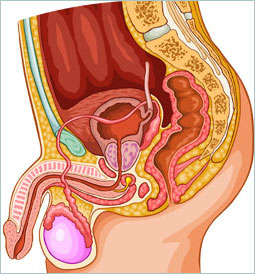P rostate Enlargement rostate Enlargement
Select from the following topics to learn more about Prostate Enlargement.
Alpha-Blocker Therapy in the Management
of Urological Disorders
Activation of Alpha adrenergic receptors for smooth
muscles causes the smooth muscle to contract. Alpha
blockers, therefore, produce smooth muscle relaxation
by inhibiting contraction of this type of muscle. There
are multiple types of alpha receptors resulting in
different levels of selectivity of the alpha blockers.
Alpha blockers have
been shown to improve urinary symptoms by virtue of relaxation of
the smooth muscle of the prostate and the bladder neck. This results in an increase in urinary
flow, decrease in urinary dribbling, decrease in residual volume, and can improve urinary
frequency and urgency.
Click here to read more.
Alternative Treatments For BPH
In some men, the growth of prostate is outward giving the gland increased overall size. This growth causes blockage by sheer increase in prostate size with impingement on the urinary channel or urethra. In others, the outward growth is minimal but the blockage is caused by increased muscle tone around the urinary channel or urethra. Many men develop both types of obstruction, gland growth and increased muscle tone.
Click here to read more. 
Diagnostic Evaluation of Urinary Symptoms in Men
Historically urinary tract symptoms (LUTS) in men over the age of 50 were almost always attributed to enlargement the prostate gland or benign prostatic hyperplasia (BPH), thereby causing bladder outlet obstruction (BOO). We now know quite clearly that many patients with LUTS have no BOO. We now know clearly that many patients with LUTS caused by BOO do not have BPH. These terms are complicated but our expanding research into the physiology of patients with urinary symptoms has clearly shown us that many men have other diagnoses for their symptoms and that treating the prostate for symptoms not caused by prostate enlargement has only a small chance of being successful.
Click here to read more.
Minimally Invasive Therapies for Enlarged Prostate Glands
Benign enlargement of the prostate gland (BPH) is a common condition that affects nearly all men over the age of 50. The prostate is a walnut-sized gland located beneath the bladder which surrounds the urethra or the tube in the penis that allows urine to exit the body.
Click here to read more.
New Options for Treating Enlarged Prostate Glands
Developing symptoms of an enlarged prostate gland is an inevitable aspect of aging for most men. With the aging of the baby boomers, more and more men will develop symptoms of prostate enlargement and will be looking to their physicians for relief of this common condition. Now there are new treatments for benign prostatic hyperplasia (BPH), the medical the term for nonmalignant enlargement of the prostate gland. Though not a deadly disease like prostate cancer, BPH is actually far more common, appearing in some men as young as 40, and affecting nearly 60% of men over 60 years of age. It is estimated that the condition affects nearly 14 million American men and more than 8 million men are receiving treatment.
Click here to read more.
Prostatitits
Prostatitis is an inflammation of the prostate. How common is it? In the US, over one million patients visits per year are for prostatitis. The following information will answer some of your questions on prostatitis, as well as those about the prostate itself--where it is, what is does.
Click here to read more.
[Top] Reprinted with permission from Neil Baum MD (neilbaum.com) and Dialog Medical, (dialogmedical.com).
Quick navigation links:
What is a Urology Center | Urologist | Urology Conditions | Urology Services | Resources for Health | Contact Urology Center in North Texas | Sitemap | Home
Disclaimer:
The pictures displayed in www.TexasUrology.com are images of actual patients and employees who have consented to have their picture in this website.

Website Design & Educational Content © Copyright 2023 MedIngenuity, LLC
Medingenuity develops content-rich educational web sites for urologists and urology group practices.
|